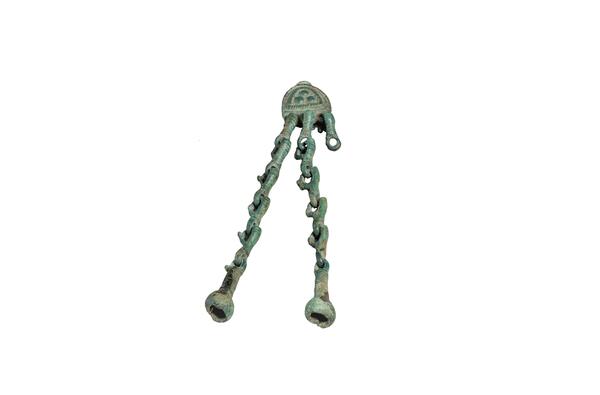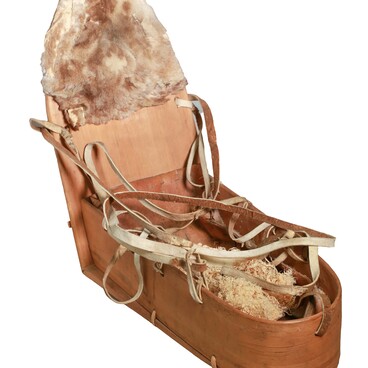The Northern peoples believed that metal ringing scares evil spirits, so such jewelry was often worn, especially by shamans, women, and children. These items consisted of several elements or had pendants that made a rattling sound when a person was walking.
Noise-making pendants from the museum collection appeared in the Middle Ages; they belong to Kintusovo culture. Kintusovo culture is a complex of finds dating back to the 9th — 13th centuries AD. The monument of this period is known to historians as “Kintusovo burial ground”. It was first explored in 1911. Now it has been renamed to “Ensemble Kintusovskoye 4”. It includes an ancient settlement, a hillfort, a cemetery, and a sanctuary, which, although dating back to different periods, are located on the same territory.
The decorations found in the burial ground are notable for their artistic expressiveness, therefore archaeologists assume they were made by the masters from Volga Bulgaria. Metalworking is one of the ancient crafts of the Bulgars. Scientists note that the Volga craftsmen mastered almost all jewelry art of that time, which made them famous all over the world. Bulgarian artworks were exported to the Baltics, Western Europe, the Middle East, sold in Siberia and the Southern Urals. The wealthy residents of Western Siberia exchanged furs for exquisite jewelry of recognized masters.
The shield of the bronze pendant from the Nefteyugansk collection is ornamented in the center with a pattern of metal pearls in the form of a pyramid. The pearls are edged with an imitation of a curl cord. The outer edge of the shield is decorated with the same cord. There is a loop at the top of the shield, and chains of six links are attached to it from below. One of the three chains is lost. Perhaps, the decoration got into the burial ground already in this state. There is an ancient tradition, according to which objects were deliberately damaged before being buried with a person. It was done so that the items could take their “real” form and serve the deceased as they did in the world of the living.
Noise-making pendants from the museum collection appeared in the Middle Ages; they belong to Kintusovo culture. Kintusovo culture is a complex of finds dating back to the 9th — 13th centuries AD. The monument of this period is known to historians as “Kintusovo burial ground”. It was first explored in 1911. Now it has been renamed to “Ensemble Kintusovskoye 4”. It includes an ancient settlement, a hillfort, a cemetery, and a sanctuary, which, although dating back to different periods, are located on the same territory.
The decorations found in the burial ground are notable for their artistic expressiveness, therefore archaeologists assume they were made by the masters from Volga Bulgaria. Metalworking is one of the ancient crafts of the Bulgars. Scientists note that the Volga craftsmen mastered almost all jewelry art of that time, which made them famous all over the world. Bulgarian artworks were exported to the Baltics, Western Europe, the Middle East, sold in Siberia and the Southern Urals. The wealthy residents of Western Siberia exchanged furs for exquisite jewelry of recognized masters.
The shield of the bronze pendant from the Nefteyugansk collection is ornamented in the center with a pattern of metal pearls in the form of a pyramid. The pearls are edged with an imitation of a curl cord. The outer edge of the shield is decorated with the same cord. There is a loop at the top of the shield, and chains of six links are attached to it from below. One of the three chains is lost. Perhaps, the decoration got into the burial ground already in this state. There is an ancient tradition, according to which objects were deliberately damaged before being buried with a person. It was done so that the items could take their “real” form and serve the deceased as they did in the world of the living.



